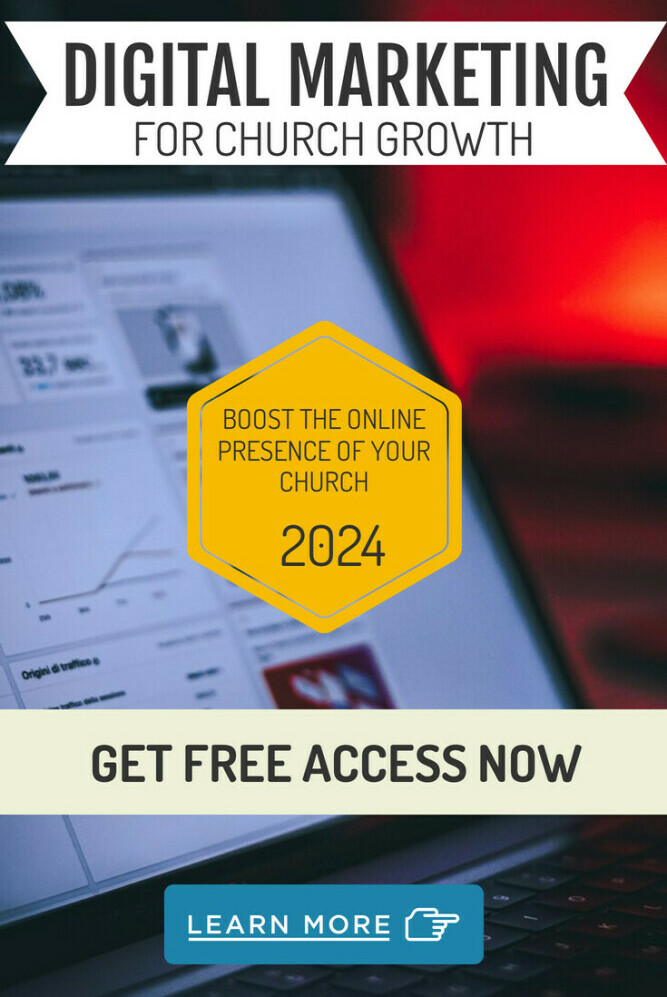Best Practices For A Landing Page when Designing One For Your Church
Having a strong online presence is crucial for churches looking to expand their reach and engage with their community. You may wonder what are the the best practices for a landing page when designing one for you church.
Check out these power packed tips and techniques.
One key element of a successful digital marketing strategy for church growth is designing an effective landing page.

Your church's landing page serves as the first impression for online visitors, making it essential to optimize it for maximum impact.
In this blog post, we will explore the best practices for designing a compelling and user-friendly landing page that will help drive engagement and foster connections within your congregation.
Clear and inviting headlines that reflect your church's mission
Crafting compelling and inviting headlines that reflect your church's mission is a crucial element in designing an effective landing page for your digital marketing strategy.
Your headline is the first thing visitors see when they land on your page, so it must clearly and succinctly communicate the essence of your church's mission and values.
A strong headline not only captures attention but also sets the tone for the rest of the content on your landing page.
When designing your church's landing page, consider using headlines that resonate with your target audience and convey the unique aspects of your church's message. Incorporate keywords that potential visitors might be searching for to optimize your page for search engines.
For example, if your church focuses on community outreach, a headline like “Join Us in Making a Difference: Embracing Love and Service” can convey your mission effectively.
Remember to keep your headlines concise and to the point, avoiding jargon or overly complex language.
By crafting clear and inviting headlines that reflect your church's mission, you can pique the interest of visitors and encourage them to explore further, ultimately leading to growth and engagement within your church community.
Use of high-quality images and videos to evoke emotion
Creating an engaging online presence for your church is essential for growth. One powerful way to captivate visitors and evoke emotion on your church's landing page is through the strategic use of high-quality images and videos.
Visual content has the unique ability to convey emotions, tell stories, and create a connection with your audience. When designing your church's landing page, consider incorporating vibrant and meaningful images that reflect the spirit and message of your church.
Choose photos that showcase your congregation in prayer, worship, community service, or other impactful moments.
These images can evoke feelings of warmth, inclusivity, and inspiration, helping visitors connect with your church on a deeper level.
In addition to images, incorporating videos on your landing page can further enhance the emotional appeal. You can feature videos of sermons, testimonials from congregation members, highlights of past events, or virtual tours of your church.
Videos have the power to engage visitors in a dynamic way, allowing them to experience the essence of your church firsthand.
By leveraging high-quality images and videos on your church's landing page, you can create a visually compelling and emotionally resonant online presence that attracts and engages visitors, ultimately fostering growth and community involvement.
Strategic placement of calls-to-action (CTAs) for increased engagement
When designing your church's landing page, strategic placement of calls-to-action (CTAs) is crucial for increasing engagement and encouraging visitors to take action.
CTAs serve as signposts guiding visitors on what steps to take next, whether it's signing up for a newsletter, scheduling a visit, or donating to a cause.
Placing CTAs strategically throughout your landing page can significantly impact user engagement and conversion rates. One effective strategy is to place CTAs prominently above the fold, ensuring they are visible without the need to scroll.
This prime real estate captures visitors' attention immediately and encourages them to take action right away.
Additionally, incorporating compelling and action-oriented language in your CTAs, such as “Join Us for Sunday Service” or “Get Involved Today,” can create a sense of urgency and motivation for visitors to engage with your church.
Furthermore, consider utilizing multiple CTAs throughout your landing page to cater to different visitor segments and their unique needs.
By offering a variety of CTAs that align with the diverse interests of your audience, you can maximize engagement and drive conversions.
Whether it's a button, link, or form, each CTA should be visually appealing, easy to locate, and clearly communicate the value proposition to visitors.
By strategically placing CTAs on your church's landing page, you can create a seamless and engaging online experience that encourages visitors to connect with your community, participate in events, and ultimately contribute to your church's growth.
Incorporating testimonials and stories to build trust
Incorporating testimonials and stories to build trust is a powerful strategy when designing your church's landing page for growth.
Testimonials provide social proof and validate the positive experiences of others within your church community. Sharing stories of transformation, faith journeys, and impactful events can resonate with visitors and create a sense of authenticity and connection.
When potential visitors come across genuine testimonials from current members sharing their personal experiences and growth within the church, it can help build trust and showcase the positive impact your church has had on individuals' lives.
By incorporating real-life stories of how your church has made a difference, visitors can see the tangible results of being part of your community.
Including testimonials and stories on your landing page can humanize your church, making it more relatable and inviting to those exploring your online presence.
It allows visitors to envision themselves as part of your community and fosters a sense of belonging even before they step foot in your physical location.
Remember to highlight a diverse range of testimonials form different walks of life and stories to showcase the inclusive and welcoming nature of your church.
By incorporating authentic experiences and voices, you can effectively build trust and encourage visitors to take the next step in their faith journey by engaging with your church.
Mobile optimization: catering to users on the go
When designing your church's landing page, one of the best practices to focus on is mobile optimization.
With more people accessing the internet through their smartphones and tablets, it's essential to cater to users on the go. Mobile optimization ensures that your church's landing page is responsive and user-friendly on all devices, including smartphones and tablets.
This means that visitors can easily navigate your page, access important information, and engage with your content seamlessly, regardless of the device they are using.
By optimizing your church's landing page for mobile users, you can create a positive user experience and make it easier for people to connect with your church online.
When designing for mobile optimization, consider the layout, font size, and navigation of your landing page. Keep the design clean and simple, prioritize important information, and make sure that buttons and links are easy to click on smaller screens.
By prioritizing mobile optimization in your church's online presence, you can effectively engage with users on the go and attract new members to your congregation.
SEO best practices for church websites: improving visibility
Last but definitely not least is when it comes to designing a church's landing page for growth, one crucial aspect that should not be overlooked is Search Engine Optimization (SEO).
Implementing SEO best practices for church websites can significantly improve visibility and attract more visitors to your online presence.
By optimizing your church website for search engines, you can ensure that individuals seeking spiritual guidance or community involvement can easily find and connect with your congregation.
If you are interested in getting access to 5 FREE videos of my SEO course you can do so by going here.

To enhance the visibility of your church website, consider incorporating relevant keywords and phrases that potential visitors may use when searching for a church in your area.
Include keywords related to your church's denomination, location, and any specific ministries or services you offer.
By strategically placing these keywords throughout your landing page content, meta tags, and headers, you can increase the likelihood of your website appearing in search engine results for relevant queries.
Additionally, optimizing your church website for local search is essential for attracting nearby residents who may be searching for a spiritual community in their area.
Make sure to include your church's address, contact information, and a Google Maps embed on your landing page to improve local SEO.
If you would like to see how our church has implemented this strategy on our landing page, you can go here.
Encouraging satisfied congregants to leave positive reviews on platforms like Google My Business can also boost your church's online visibility and credibility.
By implementing SEO best practices for your church website, you can enhance visibility, attract more visitors, and ultimately foster growth within your congregation.
Prioritizing search engine optimization as part of your online presence strategy can help your church effectively reach and engage with individuals seeking spiritual connection and community involvement.
Conclusion
We trust that our blog post on designing your church's landing page for growth has provided you with valuable insights and practical tips.
Your church's online presence is crucial in reaching out to a wider audience and fostering growth within your congregation.
By implementing the best practices outlined in this article, you can create a more engaging and compelling landing page that resonates with visitors and encourages them to connect with your church community.
We hope that these strategies will help your church thrive both online and offline.
If you have any questions or need further assistance in enhancing your digital marketing efforts, please leave a comment in the comment section below or contact us via our contact us page.
Cheering you on for success!
